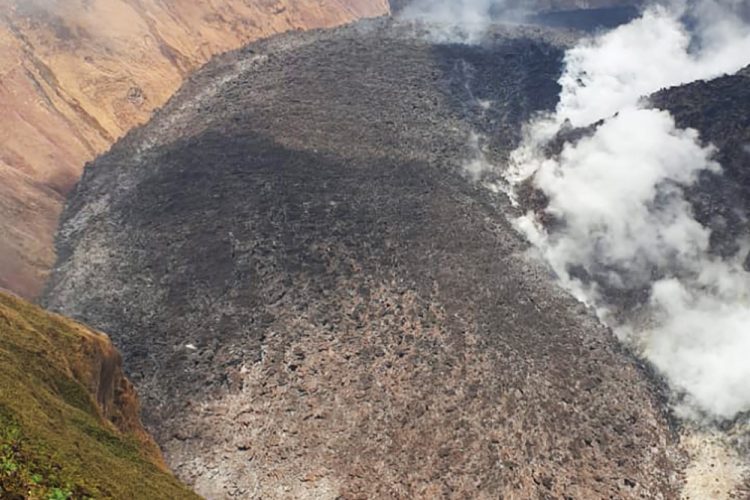Northern residents on edge as Soufriere rumbles, shakes

THE LA SOUFRIÈRE VOLCANO is keeping the residents living underneath its shadow on edge.
And, the scientists monitoring the spewing monster are making sure to keep a close eye on it, following the recent changes in its activity.

On Wednesday, March 24, just before six in the evening, a rigorous shake jolted residents in North Windward communities who have lived near the effusively erupting volcano since December.
This time, the tremor was different; they had not experienced such a strong seismological event recorded since the volcano re-awakened.
“It was really strong, it shook whatever you were sitting on. It shook that, and then the windows, you heard the rattling on the windows. It was really strong. That was the strongest one since,” a resident of Sandy Bay commented.
“I can say for me, it sounded like – there was a rumble first, and then the shaking, so we heard before we felt it, and that’s how it’s been happening. You hear a noise first and you feel a shake after.”
Residents felt what the National Emergency Management Organization(NEMO) has revealed are volcano-tectonic(VT) earthquakes. They have been recorded by the monitoring network from Tuesday, March 23, at 4:53pm, and up to press time, have been happening periodically.
“These earthquakes are normally associated with underground fractures of the rock mass and are commonly generated by magma pushing through an unyielding rock mass,” and to the surface, NEMO explained in a release sent out on Wednesday night.
“The volcano-tectonic earthquakes were located beneath the volcano, at depths down to 10 km below the summit,” they revealed.
However, it was Tuesday morning that those monitoring the volcano noticed the first indication that magma may be moving in the depths of the volcano. At approximately 10:30 am, there was a swarm of weaker seismic events which lasted for 45 minutes, different to the events previously recorded, and felt at other seismic stations other than the one closest to the dome.
This change has reportedly resulted in the residents becoming tense.
“…Persons are saying that yes, they appreciate NEMO’s efforts to communicate, but they feel like there’s still too much science, the updates are too scientific for the layman to understand,” the Sandy Bay resident stated.
They are watching and waiting.
“I’m wondering what’s happening, how organised they(the authorities) are in terms of transporting persons out if there is an urgent evacuation. We have no idea, we know what the muster points are, we know that much, so it’s basically persons going to the muster points and waiting, not knowing what’s gonna happen from there,” the villager said.
Geologist, Vincentian Professor Richard Robertson of the University of the West Indies-Seismic Research Centre(UWI-SRC) is leading a team of scientists on the ground, monitoring the activity of the volcano.
Speaking to SEARCHLIGHT on Wednesday, he said, “up until yesterday( Tuesday, March 23), the main kind of seismic events we had from the volcano were associated with the growth of the dome,” and that these were quite low in energy. The dome that is being formed from an oozing of magma, and has been growing since last December, is now spreading across the mote around an older dome, and is operating more like a lava flow. On Wednesday, its size was approximately 13.13 million cubic metres or (17.4 million cubic yds), 921 metres (1007 yds) lengthwise, and 105 metres ( 115 yds) in height. The bigger volcanic-tectonic earthquakes, “are classic volcanic earthquakes that you normally see at the volcano when it’s erupting,” or prior to an eruption.
“…It could mean that we are moving to something slightly different which could mean that we need to keep an eye out for possibly it moving towards something that is less effusive and more explosive, but it’s something that we have to look at closely,” the scientist stated.
The Professor indicated that it hasn’t reached the stage where they can say “ ‘this’ is what it means for sure.”
However, on another media platform, Professor Robertson elaborated more on the possible courses.
The change in activity might mean “..faster dome growth or it might be explosions, we’re still looking at the data in terms of that,” Robertson said while speaking on the programme ‘Round Table Talk’ television programme also on Wednesday.
“Right now I think the most likely thing is more of the same but, don’t be surprised if it changes in the next few days or the next few weeks as we move forward,” he noted.
Speaking to SEARCHLIGHT on the topic of whether persons should be worried about the new developments, the geologist stated, “I don’t think that I would say that people have to be anymore alarmed other than being alarmed because you have an erupting volcano, that should have been alarming enough.
“I don’t think people have to be more worried, but they should have been concerned enough before, that if they live in the red, orange zone, they should have plans in place. They should really know what they might have to do if they have to move, because that’s a real possibility. It has always been a real possibility,” Robertson stressed.
“…This is just telling you again, just in case you’ve gotten a little bit complacent,” and thinking that the volcano is doing one thing, “that it could do something else.”
For those persons who may have noticed more white steam (boiled water from the crater ground) coming from the volcano, this is associated with the greater mass of the dome.
In terms of how many events it would take before the scientists become alarmed, Robertson said that it’s not that simple, as it depends on a number of factors.
“It’s not just looking at- are there ten versus 20 earthquakes. It’s also the types of earthquakes that you have, so it’s not that simple,” he explained, adding “but we keep a close eye on it.”
Up to press time the alert level remained at Orange, meaning that there is a highly elevated level of seismicity or fumarolic activity or both, or highly unusual symptoms. It also means that eruptions may occur with less than 24 hours notice.
So far, no evacuation order or notice has been issued.
[Changed at 10:01am on March 27 to reflect that Professor Richard Robertson is not a seismologist but a geologist]









